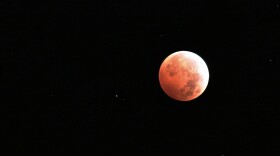-
Weather permitting, skywatchers in Arizona will be able to see a total lunar eclipse tonight — the first and only “blood moon” of the year.
-
KNAU’s Science and Technology Reporter Melissa Sevigny traveled with Lowell Observatory to Waco, Texas — one of the cities within that path of totality — to experience the Great American Eclipse firsthand.
-
On Monday, a partial solar eclipse will be visible everywhere in the lower 48 states of the U.S. Anyone standing in a narrow band stretching from Texas to Maine will experience a total solar eclipse. NAU astronomer Cristina Thomas says it's extraordinary.
-
Hundreds of millions of people in the United States are expected to watch the solar eclipse on Monday. But many Navajos follow traditional teachings to give the sun “privacy” during the event.
-
Northern Arizonans have a chance to see an annular solar eclipse this Saturday morning, with the sun 80 to 90% covered by the moon. The best views will be at Four Corners, where the moon will obscure the sun almost entirely, leaving only a bright fiery ring. Here's how to safely watch this rare celestial event.
-
A rare annular solar eclipse will be visible Saturday in eight western U.S. states, along with parts of Central and South America. Some Indigenous cultures don't promote the starry-eyed spectacle or festive viewing parties.
-
On October 14, a wide swath of the western U.S. will experience a solar eclipse. At its peak, the path of the eclipse will cross right through the Four Corners region of the Colorado Plateau.
-
The annular solar eclipse will be visible in eights states in the West and Southwest, including Arizona. NASA has released an interactive map to track the solar eclipse across its path.
-
A total solar eclipse will cross through United States one year from Saturday. Astronomers say it’s a rare, unearthly experience expected to attract hundreds of thousands of travelers from around the world… and people who want to see it should start making plans now. KNAU’s Melissa Sevigny spoke with Kevin Schindler of Lowell Observatory about what to expect.
-
A total lunar eclipse will be visible very early tomorrow morning. KNAU’s Melissa Sevigny reports, skywatchers in Arizona have prime viewing of the event from start to end.

Play Live Radio
Next Up:
0:00
0:00
Available On Air Stations








